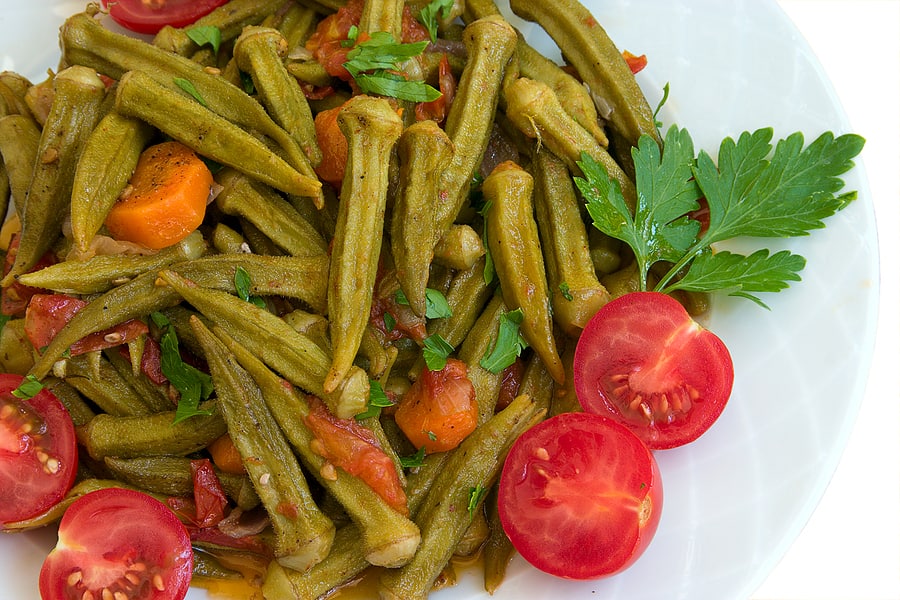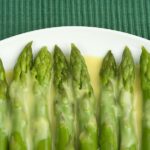Okra is easily cooked and served. Okra has a rich, sweet earthy flavor. The flavor is similar to eggplant with hints of asparagus and artichoke.
The peak okra harvest season is mid to late summer.
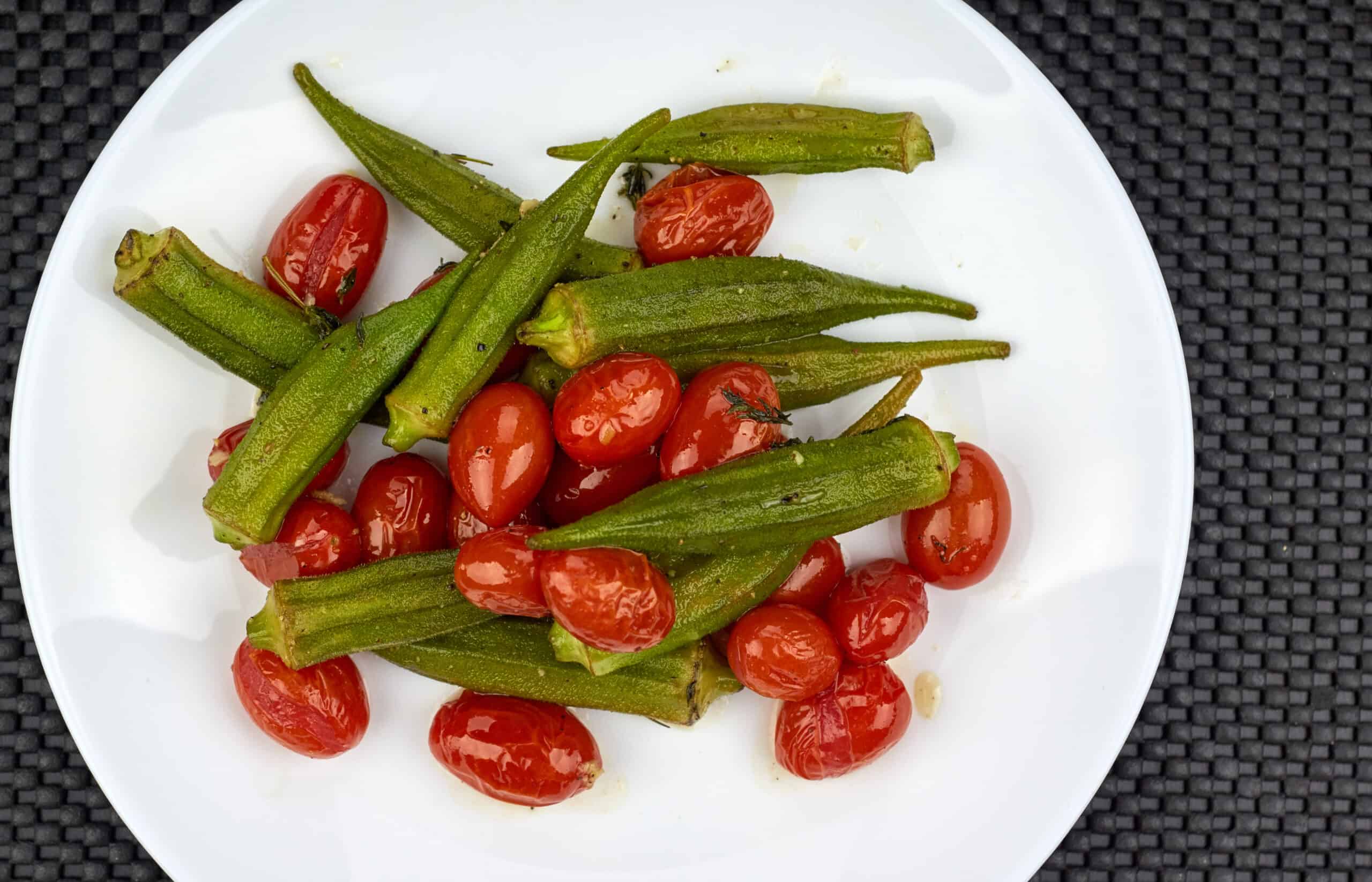
How to choose okra
- Select young, tender okra pods free of bruises. Okra pods should be firm to the touch with no browning at the tips. Select brightly colored pods less than 4 inches long. Younger pods are less glutinous. (Long, gummy pods about 7 inches (16 mm) long are preferred in some parts of the United States.)
- Avoid okra that is soft, shriveled, or dull-colored. Large okra will be tough and fibrous.
Kitchen Helpers from Amazon:
- Oster Vegetable Steamer
- Chef’s Knives Set of 6
- EZ Off Jar Opener for Weak Hands
- Pepper Core Remover Stainless Steel
- Kitchen Utensils – Set of 35
How to store okra
- Refrigerate okra in a paper bag or inside a paper towel in a perforated plastic bag for 2 to 3 days.
- Okra can be frozen after blanching whole for 2 minutes.
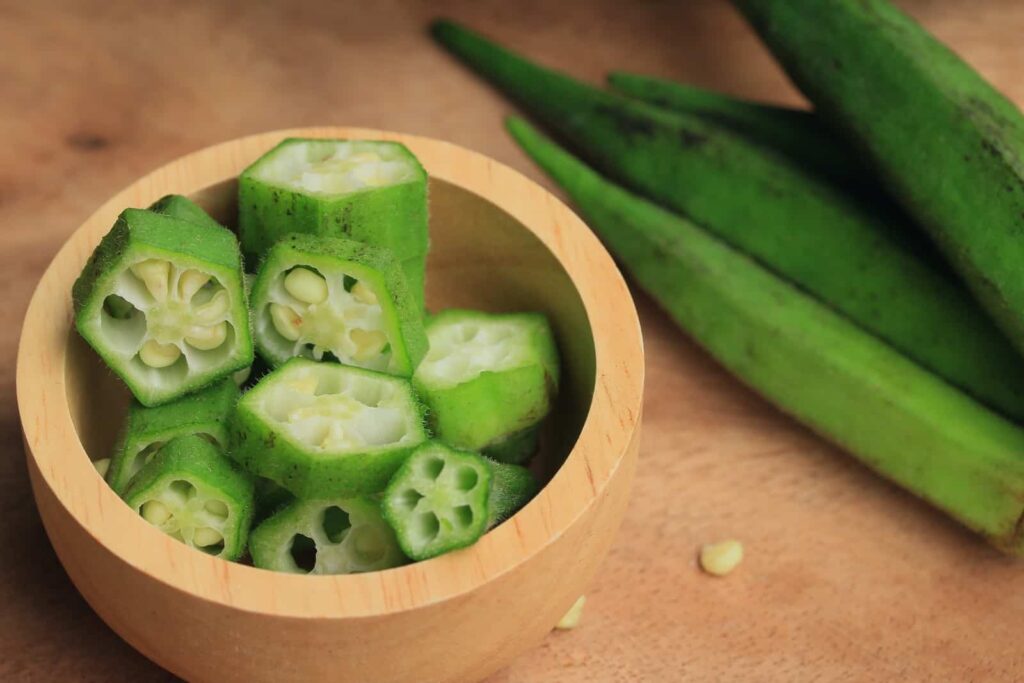
How to prep okra for cooking
- Rinse okra in cool water before using. Rinse and drain, then slice off the top and tail if the pods are to be cooked whole. Once cooked okra can be cut into slices and used to thicken soups or ragoûts.
- Trim the caps off of larger pods, but do not expose the seeds. If pods are fuzzy, remove the fuzz by rubbing the pods in a towel before you wash them.
- Do not cook okra in iron, brass, tin, or copper pots; the pods will discolor.
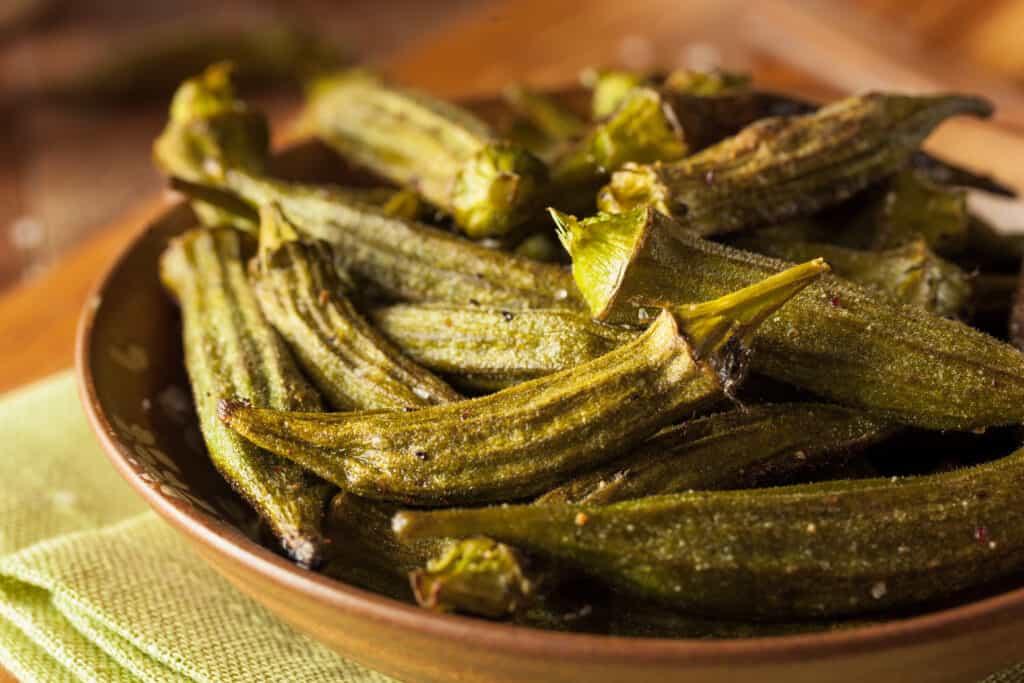
How to roast okra
- Preheat an oven to 400 degrees F.
- Remove the tough stem ends of the okra and rinse thoroughly in cold water. Roast the pods whole or cut the pods in half lengthwise for faster cooking.
- Place the okra on a roasting pan or rimmed baking sheet in a single and drizzle the pods with olive oil and lightly sprinkle with the salt. Toss to coat the pods evenly.
- Arrange the pods in a single layer on the pan or sheet.
- Roast until the pods are tender when pierced with a knife tip and the edges are browning, about 25 minutes.
- Serve the roasted pods hot or warm.

How to sauté or stir fry okra
- Remove the tough stem ends of the okra and rinse thoroughly in cold water.
- In a large saute pan, heat the olive oil over medium heat.
- Add chopped onions and minced garlic and cook until begins to soften about 2 minutes.
- Add the okra and cook until the okra pieces are tender when pierced with a knife, about 2 to 3 minutes more; stir occasionally as the okra cooks.
- Season with salt and pepper and serve hot.
How to steam okra
- Remove the tough stem ends of the okra and rinse thoroughly in cold water.
- Place a steamer basket over 1 to 2 inches of boiling water; the water should not touch the basket.
- Place the okra in the basket then cover and cook until crisp-tender, about 5 minutes.
- Toss with butter and salt and serve warm.
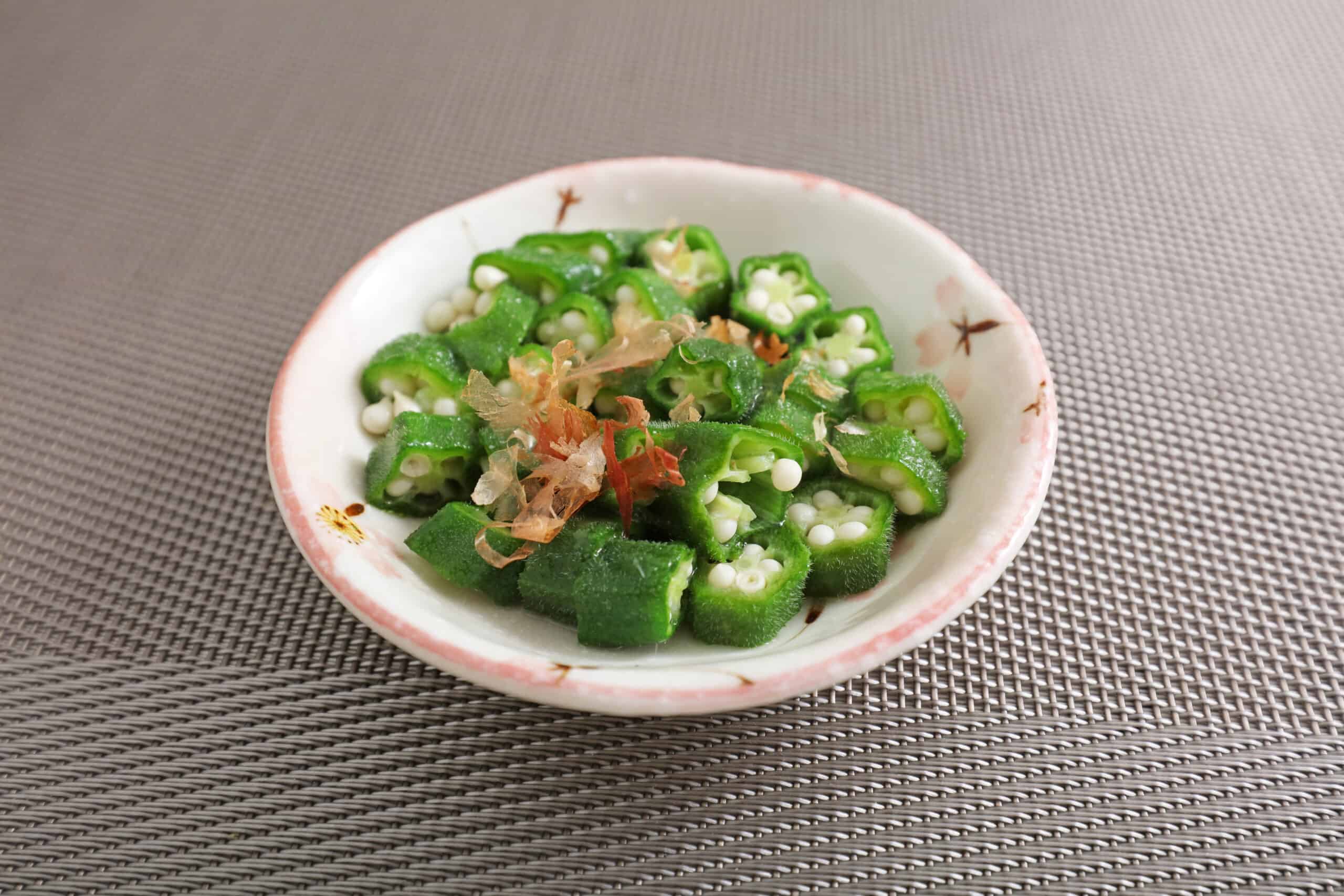
How to boil okra
- Remove the tough stem ends of the okra and rinse thoroughly in cold water.
- In a large saucepan, combine enough water to cover the okra and two teaspoons of salt.
- Bring to a boil over high heat.
- Boil for 3 to 4 minutes, or until the okra is tender when pierced with a knife tip.
- Drain the water and okra in a colander then return the okra to the saucepan.
- Add a half stick of butter and cook over low heat until the butter melts and coats the okra, stirring frequently.
How to grill okra
- Set the grill at high heat. The heat is high if you can hold your hand an inch or two above the grate for no more than 1 or 2 seconds.
- Remove the tough stem ends of the okra and rinse thoroughly in cold water.
- In a large bowl drizzle the pods with olive oil and toss to coat evenly.
- Place the pods directly on the grill or skewer them or put them in a grilling basket.
-
Cook turning occasionally with tongs until browned or lightly charred and tender when pierced with a knife tip, about 5 to 10 minutes depending on size. The color of the pods will deepen as they cook.
- Sprinkle with salt and lemon juice.
- Serve hot or at room temperature.
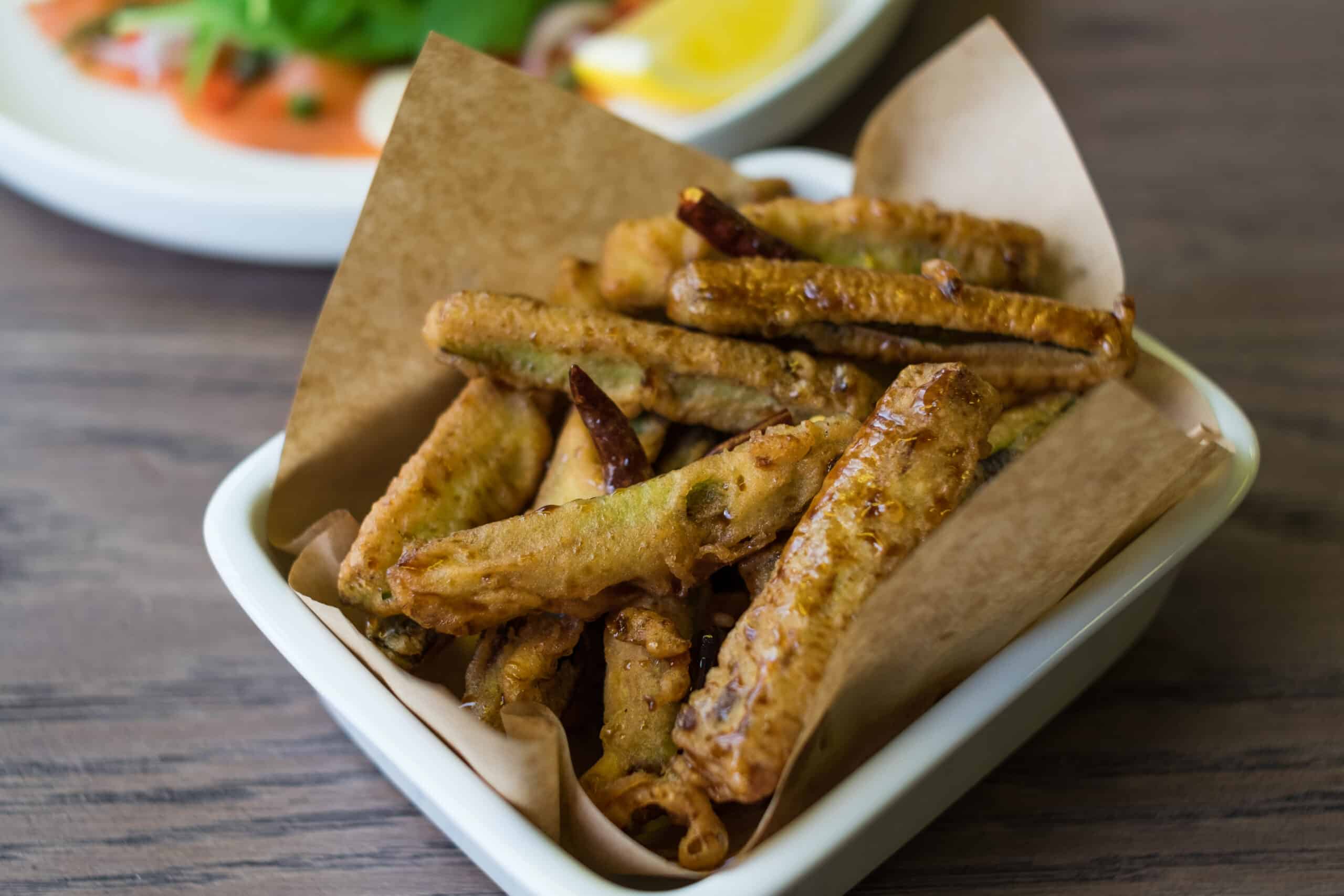
How to deep fry okra
- Place 2 inches or slightly more vegetable oil in a large, deep saucepan over medium heat.
- Remove the tough stem ends of the okra and rinse thoroughly in cold water.
- Heat the oil to 370 degrees F.
- Preheat the oven to 200 degrees F.
- Put flour in a paper or plastic bag; beat two eggs lightly in the dish; place cornmeal in a third dish.
- The okra pods in the flour in the bag, then dip in the egg, then dip in the cornmeal.
- Place the coated okra in the saucepan of heated oil and cook for 3 to 4 minutes until brown. Cook in batches if necessary
- Lift the okra with tongs and drain on a paper towel.
- Keep the okra warm in the oven on a baking sheet or roasting pan until all of the pods are cooked.
- Sprinkle with salt and pepper to taste and serve with lemon wedges.
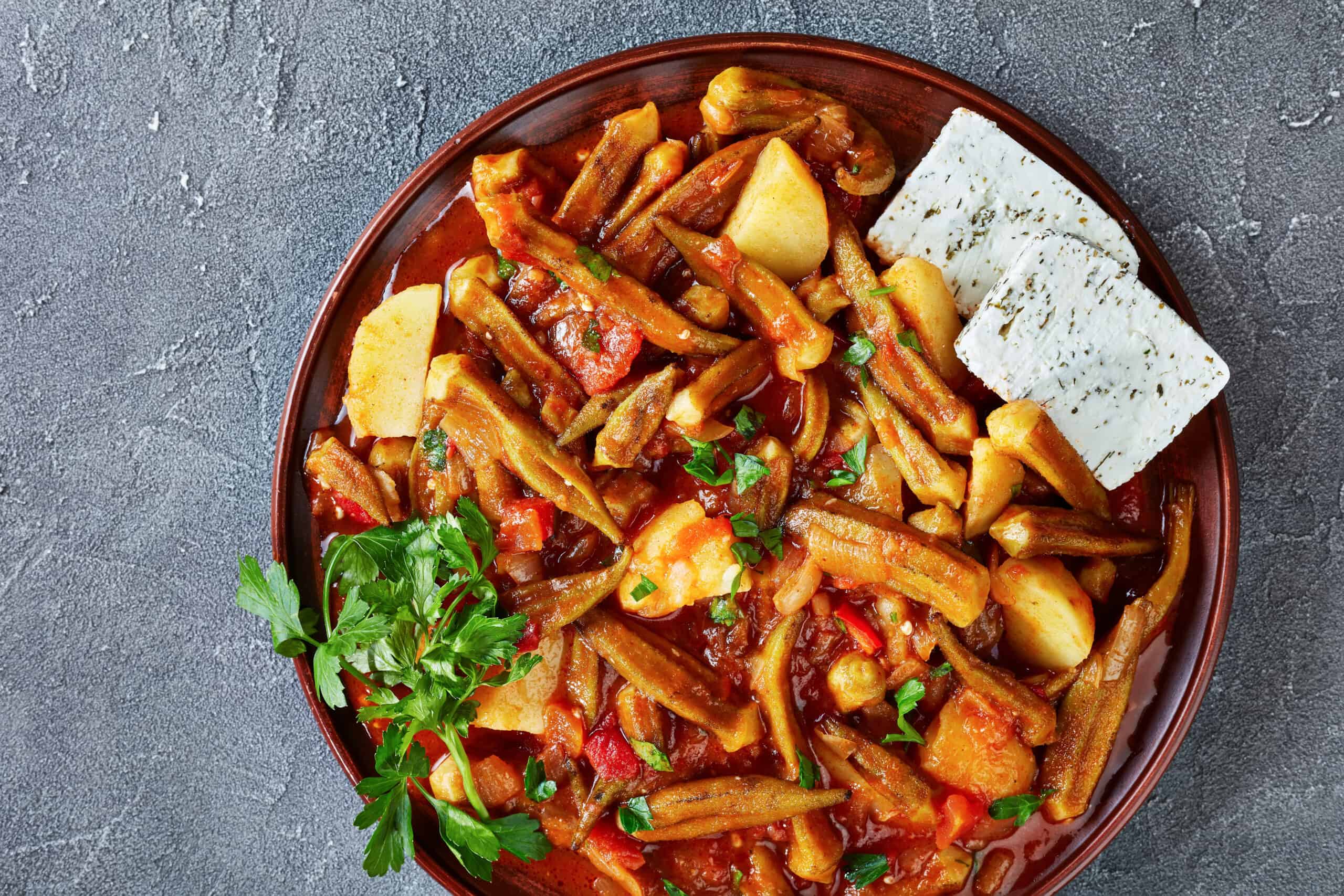
How to make okra stew–with tomatoes and corn
- Remove the tough stem ends of the okra and rinse thoroughly in cold water. Cut the pods into small pieces–about a cup’s worth.
- Remove the stems and seeds of a bell pepper and chop them into pieces–about the same size as the okra.
- Core, peel, and remove the seeds of two or three ripe tomatoes.
- Chop one large onion.
- Place a large, deep skillet over medium heat with 2 tablespoons of canola oil.
- When the oil is hot add the onion and pepper; cook and stir occasionally until the pepper is tender about 10 minutes.
- Add the okra and tomatoes and a tablespoon of chili powder to taste.
- Turn the heat to low and stir until the okra is tender when pierced with a knife tip, about 10 minutes.
- Uncover and stir in 2 cups of fresh corn kernels.
- Raise the heat to medium and cook with the cover off for about 5 minutes stirring frequently, or cover and cook over low heat for 5 minutes.
Okra serving suggestions
- Use okra raw or cooked.
- Okra can be steamed, boiled, sautéed, baked, deep-fried, braised, or made into soup or cut raw into a salad.
- Eat okra raw in salads. Wash the pods and clip off the ends. Soak the pods in water with a dash of lemon juice for about 30 minutes, drain, rinse, and dry.
- Serve okra cold with vinaigrette or add to a salad after a quick blanching.
- Cook okra as you would asparagus or eggplant; okra can replace those vegetables in most recipes. Substitute okra for zucchini in ratatouille.
- Use okra in soups, stews, and curries or sautéed or fried to accompany meat or poultry.
- Steam okra alone or with other vegetables or serve as a side dish. Arrange on a steamer rack, cover, and steam over simmering water until tender.
- Simmer okra with eggplant, onions, and chopped ripe tomatoes.
- Boil okra in a small amount of salted water for 8 to 15 minutes or till tender. Drain, chill and serve with vinaigrette or a dip.
- Pan-fry sliced okra rounds in olive oil over medium heat then flavor with cumin, tomato, and lemon juice.
- Deep fry okra: wash and dry pods, cut in half lengthwise, roll in salted yellow cornmeal until coated, and fry vegetable oil heated to 365°F until golden brown about 3 minutes. Remove with a slotted spoon and drain. Or dip okra pods in flour, egg, and cornmeal and deep-fry until golden brown and serve with lemon and hot sauce.
- Serve okra soup stews over fluffy white rice to soak up juices.
- Serve okra with stewed tomatoes: add okra to hot stewed tomatoes for 8 to 10 minutes and simmer.
- Use okra in gumbo for thickening and flavor. Add diced okra to gumbo, Brunswick stew, or rice pilaf. Add about 10 minutes before the end of cooking. Okra will thicken like cornstarch.
- In India, okra–called bhindi—is used to accompany curries.
If okra is overcooked, the pods will become gluey. To cure this, add a little lemon juice to the pan and cover.
Okra flavor partners
- Okra has a flavor affinity for chiles, corn, cornmeal, lemon, onion, rice, sweet peppers, tomato, and vinegar.
- Season okra with curry, coriander, lemon, marjoram, oregano, parsley, or vinegar.
- Partner okra with late summer crops such as garlic, onions, tomatoes, and sweet peppers.
Okra nutrition
- Okra contains vitamins A and C and is a good source of potassium, magnesium, and folic acid.

Get to know okra
- Okra is an upright annual plant that grows to about 3 feet (1m) tall with a hibiscus-like flower. The okra plant produces slender, tapered, five-sided edible pods that can be red, white, or green and are sometimes called ladies’ fingers. The pods are eaten as a vegetable.
- Okra pods range in size from 2 to 8 inches (5-20 cm) long. The pods can be smooth or slightly fuzzy in texture. Each pod contains sections of edible green or brownish seeds. Okra tastes best when the pods are harvested 2 to 4 inches (5-10 cm) long.
- Okra pods contain a gummy, slippery substance that tends to become more slippery or gelatinous when cooked. It’s that mucilaginous texture that helps to thicken soups, stews, and gumbo.
- Okra is native to tropical Africa and Asia. The West African Ashanti language word for okra is ki ngombo. After African slaves arrived in the West Indies and American South in the seventeenth century that word was shortened to gombo or gumbo. Today okra grows as far north as Virginia in the United States.
- Okra has been cultivated by the Egyptians since the twelfth century. From Egypt, okra was traded around the Mediterranean and to India, Southeast Asia, and China.
- Okra is commonly eaten in Africa, India, the Middle East, the West Indies, South America, and Louisiana. It is often used in Creole and Cajun cookery.
The botanical name for okra is Hibiscus esculentus (formerly Abelmoschus esculentas).
Also of interest:
Seven Ways to Cook and Serve Okra
Okra Growing Problems: Troubleshooting
Articles of interest:
Best Herbs for Container Growing
Garden Planning Books at Amazon:
- Vegetable Garden Almanac & Planner
- Kitchen Garden Grower’s Guide Vegetable Encyclopedia
- Vegetable Garden Grower’s Guide
- Tomato Grower’s Answer Book
More kitchen tips:
Bring your harvest to the table. Kitchen prep tips and easy recipes for the vegetables you grow. Click below for vegetable prep and recipes you can use now.
- Almonds
- Apples
- Apricot
- Aprium
- Artichoke
- Arugula
- Asparagus
- Avocado
- Bamboo Shoots
- Banana
- Basil
- Beans, Dried
- Beans. Long
- Beans, Shell
- Beans, Snap
- Beets
- Bitter Melon
- Blackberry
- Bok Choy
- Broccoli
- Broccoli Raab
- Brussels Sprouts
- Cabbage
- Cardoon
- Carrots
- Cauliflower
- Celeriac
- Celery
- Chard
- Chayote Squash
- Cherimoya
- Cherries
- Chestnut
- Chickpea
- Chinese Cabbage
- Chives
- Cilantro
- Citron
- Clementine
- Collards
- Coriander
- Corn, Sweet
- Corn, Baby
- Corn Salad, Mache
- Cranberry
- Cress
- Cucumber
- Daikon
- Dandelion
- Dill
- Eggplant
- Endive, Belgian
- Endive and Escarole
- Fava Beans
- Fig
- Florence Fennel
- Garlic
- Ginger
- Grapefruit
- Grapes
- Guava
- Horseradish
- Jerusalem Artichoke
- Jicama
- Jujube
- Kale
- Kiwifruit
- Kohlrabi
- Kumquat
- Leeks
- Lemongrass
- Lemons
- Lettuce
- Lime
- Mache (Corn Salad)
- Mandarin Orange
- Mango
- Maple Syrup
- Marjoram
- Melons
- Michihili
- Mint
- Mizuna
- Mushrooms
- Mushrooms, Cremini
- Mustard Greens
- Napa Cabbage
- Nectarine
- Okra
- Olives
- Olive oil
- Onions
- Oranges
- Oregano
- Parsley
- Parsley Root
- Parsnips
- Passion Fruit
- Pawpaw
- Peaches
- Pears
- Peas, Garden Snap
- Peas, Snow
- Pei Tsai
- Peppers, Chili
- Peppers, Sweet
- Persimmon
- Pineapple
- Pineapple Guava
- Plantain
- Plums
- Pluots
- Pomegranate
- Potatoes
- Prickly Pear
- Pumpkin
- Quince
- Radicchio
- Radishes
- Raspberries
- Rosemary
- Rhubarb
- Rutabaga
- Sage
- Salsify
- Sauerkraut
- Savory
- Shallots
- Sorrel
- Spinach
- Squash, Summer
- Squash, Winter
- Strawberries
- Sunchokes
- Sunflower
- Sweet Potato
- Swiss Chard
- Tangerine
- Taro
- Tarragon
- Thyme
- Tomatillo
- Tomato
- Turnip
- Turnip Greens
- Yams


